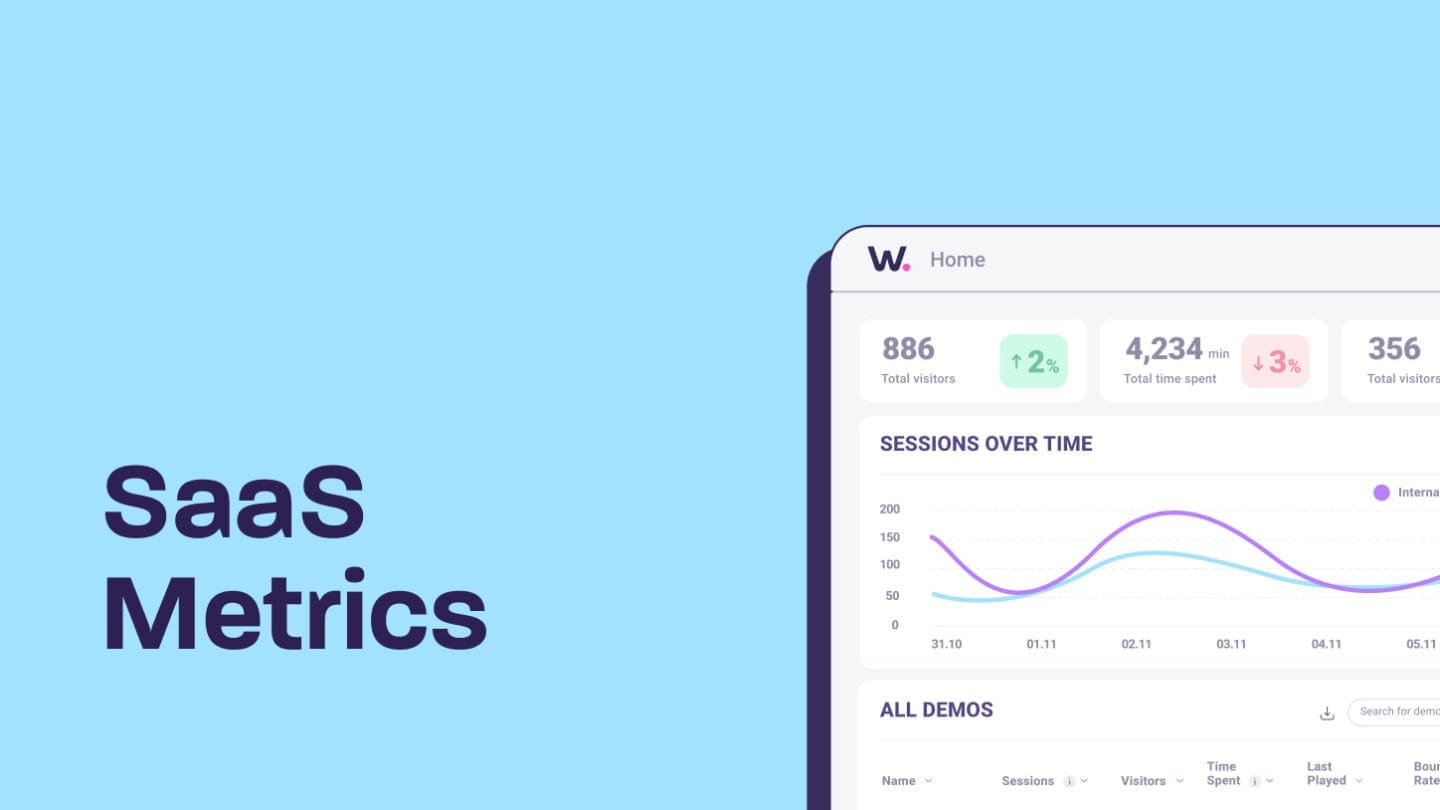Updated December 7, 2023.
If there’s one thing that the past few years have taught us, it’s that the future is uncertain.
As sales leaders look ahead to 2024, what should they prepare for? What trends, best practices, and new learnings can be used to forge a strong position for the upcoming year?
Looking at the latest data, research, and best practices, we look ahead to what sales leaders should be focused on in 2024 and beyond.
- Key trends according to sales data for 2024
- Buyers want to see multiple demos at different points throughout the sales funnel
- AI is being utilized more as part of SaaS sales strategies
- Buyers are self-educating before meeting with sales teams
- The number of stakeholders that need to see a demo is increasing
- Sales reps are becoming more like consultants as opposed to sellers
- Buyers expect a more personalized sales process
- Buyers’ needs are evolving quickly
Key trends according to sales data for 2024
Without further ado, let’s dive into the top trends that sales pros should be on the lookout for as we make our way into 2024:
1. Buyers want to see multiple demos at different points throughout the sales funnel
The top trend to watch for in 2024 is the growing need for full-funnel demos.
As part of old school sales processes, prospects would need to go through multiple rounds of discovery calls before being able to see the product during the live demo phase.
But this kind of approach to the sales process doesn’t meet modern buyers’ needs.
Buyers in today’s market don’t want to have to wait until the demo call to see your product. They want to be able to see your product whenever they want to in the sales funnel, and view it at their own pace.
In fact, according to Walnut data, buyers view an average of 3.4 demos per deal — throughout the sales funnel.
This is not to say that live demos will become less prevalent in 2024, but rather, more and more sellers are offering additional demos throughout the sales process that buyers can engage with.
One of Walnut’s customers, SailPoint, understood that they needed to change their approach to demoing to fit the evolving needs of modern buyers and ensure they were consistently delivering value at every point throughout the funnel.
“Once we started using Walnut, our team was confident that we’re all going to present the value of our product in a way that works for our customers. And this has helped us improve the buying experience across the entire funnel.” — Ian Gritter, Global Leader, Solution Engineering Strategy at SailPoint
2. AI is being utilized more as part of SaaS sales strategies
According to Salesforce’s State of Sales report, sales leaders expect the adoption of AI to grow faster than any other technology.
Not to mention, Salesforce also found that high-performing teams are almost 5X more likely to be using AI as part of their tech stack than underperforming teams.
Many GTM teams have already started using AI-powered tech to improve prospecting, lead generation, automate manual tasks, get data-driven insights, as well as create and deliver interactive demos.
Some demo platforms (cough, cough like Walnut) have integrations with OpenAI to help sellers write compelling product stories with ease. As part of the presenter notes, Walnut offers an AI-powered writing assistant named Nutty that can help you edit your current notes, write new scripts, or answer any questions you may have.
While AI has already started to transform several aspects of the SaaS sales process, this trend is only expected to grow in 2024 and beyond.
Matt Green, the CRO of Sales Assembly, mentioned some simple ways to use AI to help sales teams not only save time, but also become more informed sellers so they can offer a better buying experience for prospects during Walnut’s Humans vs. The Machine webinar.
“Let’s say you’re selling to enterprise-level companies… Where AI is going to be able to alleviate some of this bandwidth is now, all you have to do is go into ChatGPT, enter the transcript of their last earnings call. And just summarize this in three points: I sell this type of product. Can you identify the right person that I need to talk to within Adobe? And based on the transcript of this earnings call, can you identify the top two or three priorities that my product is potentially going to be able to solve?
So doing that, what would normally take a sales rep 20, 30, 40, maybe even 60 minutes of research… Now, it could be done within a matter of moments and we do see a lot of really high performing sales organizations that are starting to operationalize leveraging AI in that way, just reducing the amount of time it takes to be a well-informed seller before you hop on a call.”
3. Buyers are self-educating before meeting with sales teams
Another trend expected to continue well into 2024 is that buyers are doing their homework before they meet with sales teams.
Based on data from Walnut’s Full-Funnel Report, prospects view each interactive demo an average of 3 times without the rep being present.
For modern buyers, it’s becoming increasingly important to be able to self-educate and view demos on their own time during the buying process.
When it comes to making a decision to buy a product, prospects want to not only have access to product reviews, case studies, and data regarding the impact of your company, but also to try the product for themselves.
In order to meet buyers’ changing needs, you need to make sure prospects have a way to try the product out on their own and learn how to use it without needing to be on a call with a rep.
4. The number of stakeholders that need to see a demo is increasing
Going into 2024, it’s getting more and more common to have multiple decision-makers involved in a deal.
According to Gong, closed deals have an average of at least 3 people from the buyer’s side in meetings throughout the sales cycle.
This means that to be successful in today’s market, you not only need to be in contact with multiple people within a company, but also make sure each decision-maker has a way to see the product whenever they want to.
Given that this trend stands to persist in the coming years, sellers have started using interactive demos to get the product in front of every stakeholder that needs to see it. This helps sellers because they don’t need to find a single time that works for a large group of people to view a live demo.
CT4, a Walnut customer, realized that the team could use interactive demos to expand their reach.
In some cases, CT4’s team is targeting large organizations with as many as ten different stakeholders that need to see a demo.
So, instead of scheduling demos with all of these people, the team can just share their Walnut interactive demos with every stakeholder that needs to see it. This not only saves the prospect’s time, but also helps CT4 reach more customers.
“We knew we needed to shift our strategy to not only save the prospects’ time and use the tech strategist resource more efficiently, but also expand our reach. This meant that we needed a solution that would allow us to send demos to every stakeholder that needs to see it, instead of scheduling calls with every single one of them.” — Matt Jones, Channel Sales Manager APAC at CT4
5. Sales reps are becoming more like consultants as opposed to sellers
As we mentioned before, buyers are doing research and expanding their knowledge base on their own.
This means that recently, more and more sales reps are taking on the role of a “consultant” as opposed to just a seller, with this trend expected to continue in the coming year.
With buyers coming to reps already with a basic understanding of what a particular product can do, sellers will need to focus more on meeting the buyer’s needs, answering any questions or addressing concerns they have, and building a rapport.
6. Buyers expect a more personalized sales process
As we make our way into 2024, buyers expect a tailored sales process.
And this includes the product demo.
With this in mind, it’s only becoming more common for sellers to personalize demos with the buyer’s name, company logo, and other brand elements, as well as create multiple demo templates that are customized to show specific product flows or use cases, and that cater to different personas, industries, and parts of the sales cycle.
In addition, based on Walnut research, companies use an average of 39 interactive demo templates.
So, to increase the chances of closing deals, sellers can’t rely on a single generic demo and need to make an effort to customize the buying process according to prospects’ needs.
Dan Wardle, the VP of Revenue at Vidyard, talked about the impact he sees practically when using personalization during Walnut’s Generic Sales Suck webinar.
“Everything should be personalized. You can see a direct correlation of the response rates.”
Buyers’ needs are evolving quickly
Based on these trends, we know buyers’ needs are changing.
And it’s up to you as sales leaders to meet them.
By offering shareable and personalized interactive demos throughout the entire sales funnel, you’ll not only be better able to meet these changing needs, but you’ll also be able to improve the way you sell.
Ready to revolutionize the way you sell with Walnut? Click the “Get started” button now!



